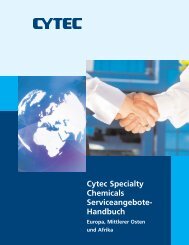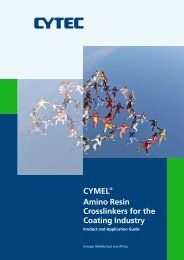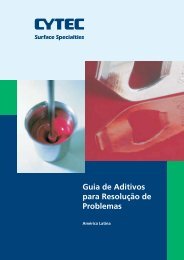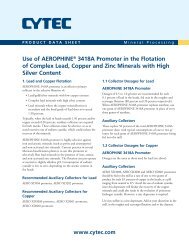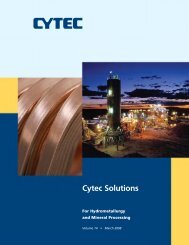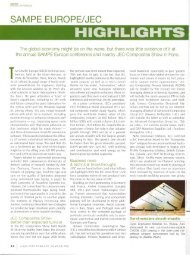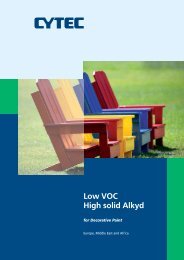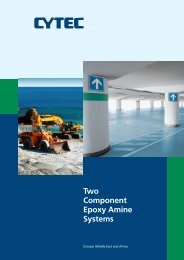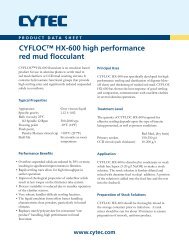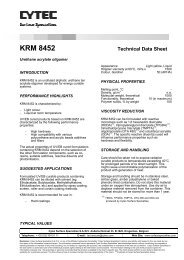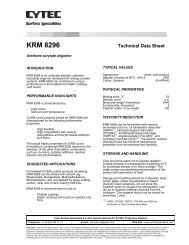Evaluation of Resins in Energy Curable Offset Inks - CYTEC Industries
Evaluation of Resins in Energy Curable Offset Inks - CYTEC Industries
Evaluation of Resins in Energy Curable Offset Inks - CYTEC Industries
You also want an ePaper? Increase the reach of your titles
YUMPU automatically turns print PDFs into web optimized ePapers that Google loves.
6 Introduction to <strong>Energy</strong> <strong>Curable</strong> <strong>Offset</strong><br />
Lithographic <strong>Inks</strong> <strong>Evaluation</strong> Capabilities at Cytec Specialty Chemicals, Americas<br />
■ Test<strong>in</strong>g Method:<br />
• Ink is applied to coated paper at<br />
appropriate film thickness us<strong>in</strong>g “Little<br />
Joe” pro<strong>of</strong>er and exposed to cur<strong>in</strong>g source<br />
• After exposure, the <strong>in</strong>k surface is<br />
vigorously rubbed with the <strong>in</strong>dex f<strong>in</strong>ger<br />
– If no <strong>in</strong>k removed, the <strong>in</strong>k is cured<br />
at this exposure. Us<strong>in</strong>g a radiometer,<br />
the energy density is measured<br />
and recorded. Also recorded is the<br />
conveyor/belt speed<br />
– The conveyor/belt speed is <strong>in</strong>creased the<br />
test is repeated until <strong>in</strong>k is removed<br />
– If <strong>in</strong> the <strong>in</strong>itial test<strong>in</strong>g, <strong>in</strong>k is rubbed<br />
<strong>of</strong>f, the conveyor/belt speed is decreased<br />
and the test repeated until <strong>in</strong>k is not<br />
removed by rubb<strong>in</strong>g the surface<br />
– The shortest exposure (lowest energy<br />
density) needed to achieve no <strong>in</strong>k<br />
removal is reported as the <strong>in</strong>k reactivity<br />
Adhesion to Non Porous Substrates<br />
■ Def<strong>in</strong>ition:<br />
Adhesion is ability <strong>of</strong> an <strong>in</strong>k to bond<br />
completely with the substrate. When there<br />
is full adhesion the <strong>in</strong>k is not removed<br />
<strong>in</strong> standard tape test<strong>in</strong>g. There are two<br />
methods used for tape test adhesion test<strong>in</strong>g –<br />
tape pull on filmic substrates and cross hatch<br />
on rigid substrates. Adhesion is typically<br />
expressed as percent <strong>of</strong> <strong>in</strong>k adher<strong>in</strong>g or<br />
rema<strong>in</strong><strong>in</strong>g on the substrate.<br />
■ Equipment:<br />
• Aetek UV Cur<strong>in</strong>g System<br />
– 1-400 watts/<strong>in</strong>. UV lamp<br />
• “Little Joe” Pro<strong>of</strong><strong>in</strong>g System with<br />
wedge plate<br />
• Specified test tape (usually 3M’s 600 or<br />
610 tape)<br />
• Cross hatch tool<br />
■ Materials:<br />
• Specified non-porous substrate<br />
– Coated<br />
– Uncoated<br />
• Ink<br />
■ Test<strong>in</strong>g Method:<br />
• Ink is applied to substrate at appropriate<br />
film thickness us<strong>in</strong>g “Little Joe” pro<strong>of</strong>er<br />
and then cured with appropriate energy<br />
density<br />
• After cur<strong>in</strong>g, a strip <strong>of</strong> test tape is applied<br />
to the <strong>in</strong>k surface<br />
– If test<strong>in</strong>g adhesion to a rigid substrate, a<br />
cross hatch tool is used to score the <strong>in</strong>k<br />
film prior to apply<strong>in</strong>g the tape<br />
• At a 60° angle, the tape is quickly ripped<br />
from the <strong>in</strong>k surface<br />
• The percent <strong>in</strong>k rema<strong>in</strong><strong>in</strong>g on the<br />
substrate is determ<strong>in</strong>ed and reported



